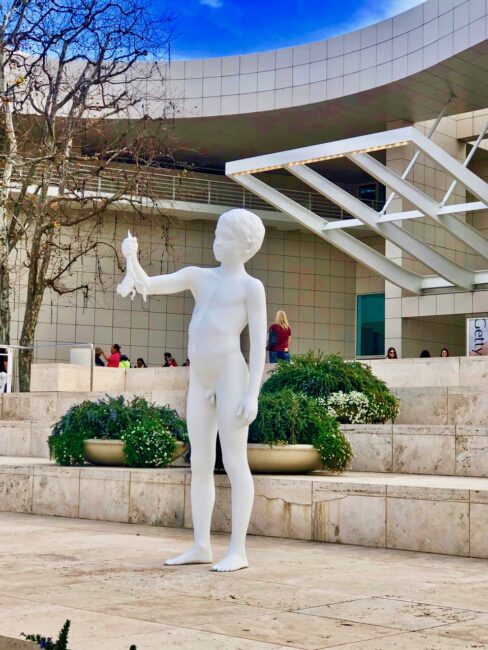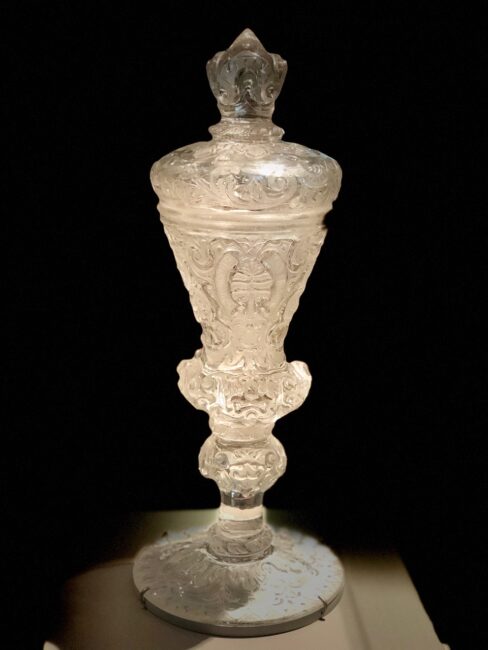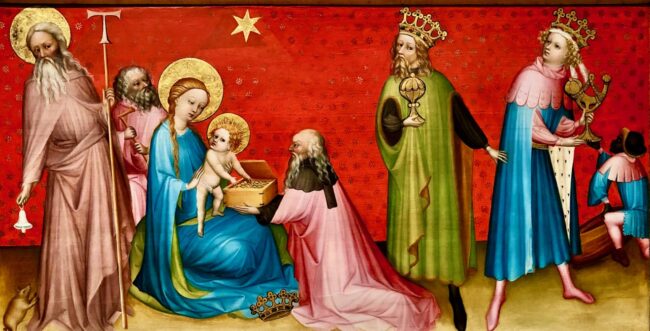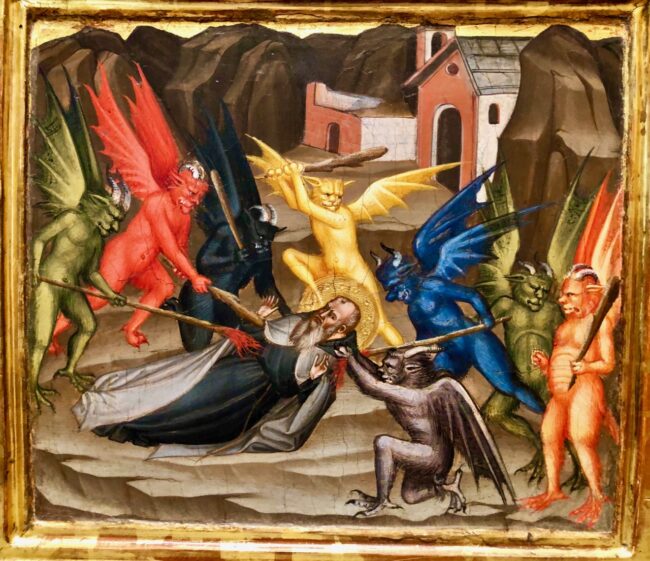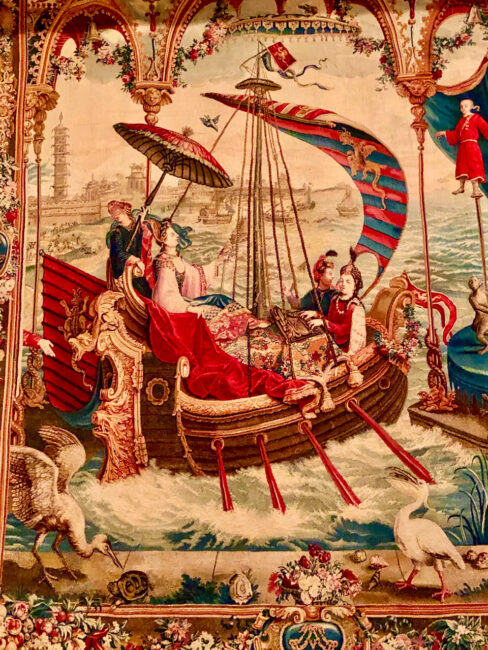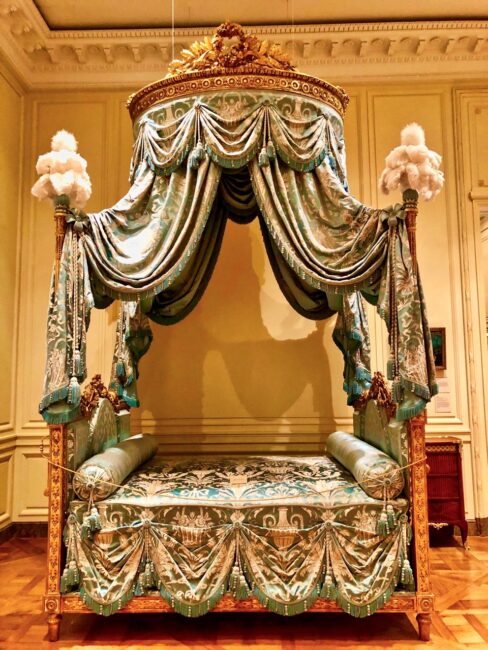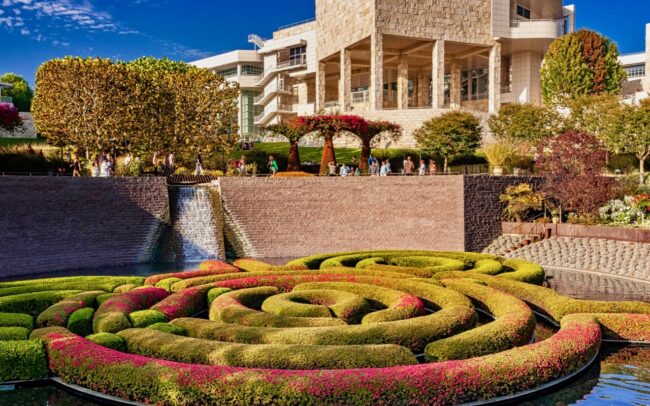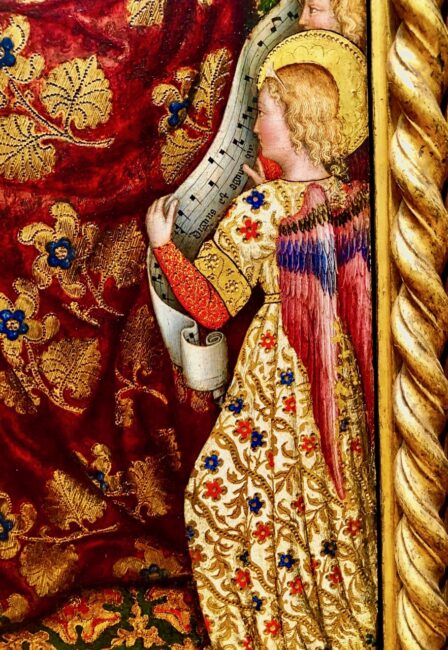
Los Angeles County Arboretum & Botanic Garden – Arcadia
May 26, 2020
Descanso Gardens – La Cañada Flintridge
July 7, 2020Artful Los Angeles Icon
Getty Center (The Getty) – Los Angeles
Last Visited: January 2020
In January 2020 BC (Before Covid), Tracy and I popped over to one of the area’s most prestigious museums, the Getty Center, early on a Sunday morning. It’s located on a 900-foot hilltop that sits above West Los Angeles. Little did we realize at the time, it would be our last visit to an indoor or outdoor museum for the next four months.
J. Paul Getty was an oil billionaire (Getty Oil Company) and avid art collector. Besides his numerous oil companies, he became fascinated with artwork in the 1930s. He accumulated so much that in the mid-1930s he opened the J. Paul Getty Museum (Getty Villa) in the hills above Malibu (seems he had something for hills) located next to his house. (Here’s a link to our visit in 2019.) He loved antiquities.
Getty bequeathed a boatload of money to the museum upon his death in 1976 and about a billion dollars of it went into the construction of The J. Paul Getty Center, which opened in 1997.
The museum includes “pre-20th-century European paintings, drawings, illuminated manuscripts, sculptures and decorative arts; and 19th- and 20th-century American and European photographs.” Hopefully the painting below will be here on your visit, because you know what they say, “Hare today, gone tomorrow.”
For architecture buffs, the Getty Center was designed by American architect and abstract artist Richard Meier in the “Modernistic Style,” The coveted competition and job had been dubbed, “The commission of the century. Meier’s “geometric designs make prominent use of the color white.” Meier, who turns 86 in October 2020, was the winner of the Pritzker Architecture Prize in 1984 and has “designed several iconic buildings, including the Barcelona Museum of Contemporary Art and San Jose City Hall.”
We parked in the underground garage and took the three-car, cable-pulled hovertrain people-mover up to the museum. (Photo courtesy of TrekEarth.)
MaiTai Tom Tip: You definitely want to be there when the museum opens at 10 a.m. to (1) get an easy parking space and (2) avoid the long line at security. While the museum is free, parking is $20 (still a bargain). If you come later in the day, after 3 p.m. the parking is less expensive, but the crowds are still large.
Entering the steps to the Getty, we were once agin greeted by the sculpture Boy With Frog, so we knew it would be a ribetting experience.
We have been to the Getty a number of times since its opening nearly 23 years ago, but surprisingly have never availed ourselves of the free guided tours. We usually grab the head-phones and wander aimlessly (as I mostly do in real life). On this outing, we joined the Collection Highlights Tour, which, as we found out, is really the Docent’s Choice Tour. This is actually a clever idea as you can take the tour multiple times with different docents and see different items because it is up to the individual docent as to what you are going to see on his or her tour.
Since we had a little time to kill before the tour, we meandered through the North Hall. First up was a 16th-century Dutch bronze of the Roman Messenger God Mercury (shadow looks like the devil) and a 16th-century Italian painting, The Birth of Bacchus, where his mom is consumed by flames. Talk about a tough childbirth.
I liked the 15th-century Swiss painting, Heraldic Panel With The Arms of the Eberler Family, where a “flirtatious maiden demurely turns away from an aggressive boar.”
The colors in this 15th-century Italian painting, Initial E: The Adoration of the Magi, popped off the walls.
Religious paintings were the order of the day in this section.
There are also lots of artifacts and manuscripts spread throughout the Getty, both in the regular and special exhibit galleries.
More Magi magic.
The Coronation of the Virgin is a work by Gentil da Fabriano sone at the turn of the 15th century.
We’ve seen some great works by the Dutch painter Rogier van der Weyden while traveling in Europe, like The Last Judgement at Hospices de Beaune ( Hôtel-Dieu) in Beaune, France.
These two were done by painters in his workshop in the 15th century. The woman on the right is Queen Isabella of Portugal.
Also from that same workshop is The Dream of Pope Sergius that borrows from van der Weyden’s “remarkable illusionist style.”
Portrait of a Woman with a Book of Music struck a chord with me.
On that note, we checked out a couple of more colorful paintings before it was time for the tour.
The Collection Highlights Tour is a one-hour tour that meets at the Information Desk about ten minutes prior to starting. Our docent was funny and knowledgeable, especially about the pieces he had selected for our group to view. Our docent started out by informing us that the reason some of the paintings are under glass is because someone tried to pick at a Van Gogh to see if it was real!! Had the culprit succeeded, I’m sure it would have cost a lot of Monet. He followed that tidbit up with a story about a recent event when the staff had to tackle someone who had uncapped a black Sharpie and appeared to be ready to write on one of the paintings!! Our docent concluded by saying, “Be careful, don’t back into the art with your back pack, don’t stab it with your selfie-stick and don’t drink in the galleries!”
Our first tour stop of the morning was The Rest on the Flight Into Egypt with Saint John the Baptist from Fra Bartolommeo (Italian from about 1509), which we had actually viewed earlier in the day. The tour guide inquired of our group, “What is the average length of time people view one particular piece of art?” I guessed ten seconds, which was close. Six seconds apparently is the average amount of time most people spend looking at one piece of artwork. You can miss a lot in six seconds.
Our guide then spent a few minutes pointing out things that we had, in fact, missed when we had looked at this piece earlier in the morning. He also told us that during the Renaissance time not many people could read, so art, including paintings and stain glass, was an important way to communicate and tell stories. One interesting tidbit he shared was that you can always identify the Virgin Mary in Renaissance paintings as she is always wearing red and blue.

Tracy and I find the jewel-tone colors of Renaissance paintings captivating. Our guide said that although these 500 year-old paintings are lush, when they were first created, the colors would have been even more brilliant. Hard to imagine.
Next up on the tour was Titan’s Portrait of Alfonso d’Avalos with a Page. Note the collar which has a pendant from the Order of Golden Fleece, which is still in existence today with, according to never in doubt and sometimes correct Wikipedia, 17 members. And, in case you’re ever on Jeopardy, it is also the logo for Brooks Brothers. (It was too dark for a photo, but I got this off a neat website called USEUM where you can download artwork for free. Check them out.)
Bernini’s Bust of Pope Paul V (Italian 1621) was Bernini’s first ever sculpture made when he was just 23-years-old, and he made it after Pope Paul V’s death, even though he had never met the Pope. The sculpture was commissioned by Cardinal Borghese who became a long-time Bernini patron.

Another MaiTai Tom Tip: When in Rome don’t miss the Borghese Gallery, one of our favorite museums in the world. All of the sculptures were created specifically for this residence and have never been anywhere else. In our opinion, especially given the two-hour time limit for viewing, you can skip the paintings on the top floor, it is the sculptures that steal the show. They are breathtaking. We also learned that when the Getty purchased this bust at auction in 2015, it was attributed to a different artist and acquired at a much lower price than would normally be paid for a Bernini. Next up, two luscious paintings from Dutch artist Jan van Huysum both from 1722, Fruit Piece and Vase of Flowers. Our guide pointed out the luminous white grapes which appear to be lit from within. Apparently as van Huysum always painted alone and never shared his techniques, they are sadly lost to time. We also learned that van Huysum only painted with fresh flowers and fruit so many times a painting would take years as he waited for a particular peony or tulip to be at peak perfection for painting.
Next up, two luscious paintings from Dutch artist Jan van Huysum both from 1722, Fruit Piece and Vase of Flowers. Our guide pointed out the luminous white grapes which appear to be lit from within. Apparently as van Huysum always painted alone and never shared his techniques, they are sadly lost to time. We also learned that van Huysum only painted with fresh flowers and fruit so many times a painting would take years as he waited for a particular peony or tulip to be at peak perfection for painting.
 Our guide next told us that all the paintings in the Getty are available for viewing online in high resolution. He brought this up to show the detail in the insects in these paintings. It is surmised that van Huysum used a human hair to paint the stripe detail on the fly.
Our guide next told us that all the paintings in the Getty are available for viewing online in high resolution. He brought this up to show the detail in the insects in these paintings. It is surmised that van Huysum used a human hair to paint the stripe detail on the fly.
Check out the amazing accuracy of the ants.
Tracy can never pass up a Vase of Flowers, even if it’s just a painting.
We then ventured outside to the viewing terrace where you can see all the way to the San Gabriel Mountains which were snow-capped on this day. We were also able to see downtown Los Angeles, Century City and all the way to Long Beach.
On a previous visit, the Pacific Ocean shimmered in the distance. The docent said this is a great place to bring a picnic and watch the sun set.
We commented on how close the fires had come to the Getty last fall. The docent said it was especially nerve-wracking as they had numerous pieces on loan from various museums around the world for a special Manet exhibition (now closed). He added that the Getty was specifically designed to be the safest place during a fire, and even during an earthquake. The museum was hermetically sealed during that nearby wildfire to protect the art from smoke. There is a one-million gallon water reservoir under the parking garage to irrigate around the museum and also to allow fire-fighting helicopters to land and refill in under 40 seconds (the helicopter landing pad is on your left on the way up the hill).
In addition, the Getty has enough food and supplies, including diapers, to feed and house 6,000 people for thirty days. They used those supplies to help care for the 200 fire fighters battling the fire, who also slept and showered at the Getty.
As we entered the next building, we paid our respects to the Portrait of Princess Leonilla of Sayn-Wittgenstein-Sayn, which probably took Franz Xaver Winterhalter less time to paint than it took me to spell.
Our final stop on the guided tour was Spring by Lawrence Alma-Tadema (1894). This is one of the few paintings in the museum which came in its original frame which was designed by the artist specifically for this painting.
Alma-Tadema fell out of fashion with “art people” who despised his paintings. At the time the Getty acquired Spring at auction in 1972, there were only two bidders. The other bidder was Alan (Candid Camera) Funt who had a collection of “bad art.”
Funt was also a collector of Alma-Tadema. Funt sold his “bad art” collection including several Alma-Tadema’s in 1973 for $570,000. A decade later the “bad” paintings had come back into fashion and are now worth millions. I doubt he was smiling when he heard about that, but I think he was candid in his comments.
Now I’m going to point out something in this painting that you will, quoting our guide, “never be able to un-see.” Check out the three ladies in the lower left-hand corner, specifically the one in the middle in the tiara. A young Bill Clinton? You be the judge!
This concluded our hour-long tour and it was on to the Impressionist paintings. Speaking of “Spring,” this painting by Édouard Manet is entitled Jeanne (Spring), and depicts actress Jeanne Demarsy, who “typifies the chic Parisian woman in her … spring ensemble.”
Renoir’s La Promenade …
… and Van Gogh’s Irises, which he painted after entering an asylum in 1889 in Saint-Rémy (cute, little town by the way). He started this painting within one week of entering the asylum. He would create nearly 130 paintings in the last year of his life while staying there.
Not too far away was a painting by the guy who created one of my favorite pieces of art, The Coronation of Napoléon. In this painting, JacqueLouis-David paints the Portrait of Napoléon’s nieces, Zénaïde and Charlotte. The bees on the settee where they are seated are the symbol of the Bonaparte family.
Not on view that day at the Getty was one of our favorites, Portrait of a Young Man in Red, which we saw on a prior visit.
We headed downstairs to what I have jokingly referred to as the Martha Stewart collection of china, silver and furnishings, otherwise known as the decorative arts. However, this time there was also an exhibition entitled Louis XIV featuring French art and artifacts.
Mai Tai Tom Fun Fact: Louis XIV’s reign of 72 years and 110 days is the longest recorded of any monarch of a sovereign country/state in history.
The Empress Sailing is a tapestry woven by frenchman Philippe Béhagle for Louis-Alexandre de Bourbon’s country home in the late 17th century.
There was a cool Wine Bottle Cooler, part of what was supposed to be a 445-piece service, that was commissioned by Louis XVI for the Palace of Versailles. A little beheading ten years later, and that was the end of that.
We also enjoyed (not physically) this 18th-century bed.
We moved to Flight of Fancy. In particular, we enjoyed seeing the Galle Chandelier, which was on special exhibition the day we were at the Getty. From the early 1800s, it resembles a hot air balloon and was made by French bronze caster and gilder Gérard Jean Galle.
The glass bowl at the bottom was originally intended to hold water and goldfish. It is one of the most popular objects in the entire museum’s collection of decorative arts.
Check out the Zodiac symbols around the outside of the globe.
The Getty always has a number of exhibitions going on. One of the more interesting was in October 2017 when we came to check out Michelangelo’s drawing Study of a Mourning Woman. It was found in the library at Castle Howard in Yorkshire, England in 1995, and this was the first time it was displayed at a museum.
We did not venture out to the gardens on this trip. Here are a couple of photos (from the internet).
The Getty has a number of outdoor sculptures, including a couple we took in 2017. On the right is The Sitting Cardinal, Cardinale Seduto. You might notice something about Angel of the Citadel – Horse and Rider – Town’s Guardian Angel. Yes, as you can see, the rider’s arms are not the only thing outstretched.
Our most recent trip to the Getty Center was complete.
If you’re visiting Los Angeles, be sure to block out a few hours to see this Southland landmark. After our last visit, I do highly recommend taking one of the docent tours that gives insight into some of the paintings. The audioguide is also a good way to navigate through the rest of the museum.
The Getty Center
1200 Getty Center Drive
Los Angeles, CA 90049
Phone: 310.440.7300
Tuesday – Friday 10 a.m. – 5:30 p.m. (5 p.m. Saturdays & Sundays)
Closed Mondays, New Years Day, Fourth of July, Thanksgiving & Christmas
Cost: Free (Parking $20 …$15 after 3 p.m.)
www.getty.edu










